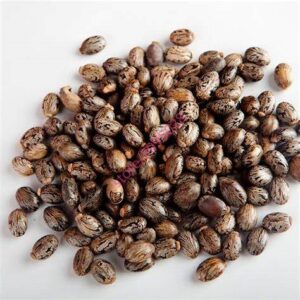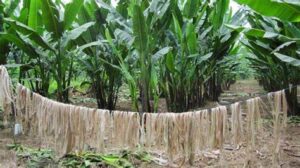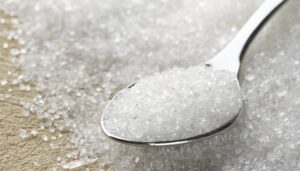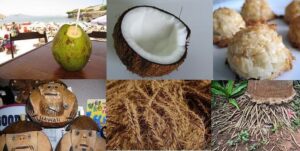In our previous blogs we discussed some interesting facts about some good naturally biodegradable resources that can replace synthetic plastic. Let us further learn about some of the other important and practical biodegradable materials in order to utilise them in our day-to-day activities:
1: Castor Beans

Pros:
• Castor bean crop is sustainable, flourishes by itself, and do not require pesticides to grow. It is a very environment-friendly crop.
• Primarily, Castor beans are used to make anti-inflammatory and cancer treatments.
• However, these days the processed castor oil is being made into castable bioplastic products for the automotive and electronic industry.
• Plastics made from castor beans are stronger and lighter than conventional petrochemicals used in vehicle production. These plastics are used to manufacture car bumpers, door trims, and panels of vehicles.
• It is believed that, using these plastics will improve the fuel efficiency and safety of cars by more than ten-fold compared to that when regular synthetic plastics are used to produce the car parts.
• Another benefit is that, this amazing plastic polymer is being used to make the flexible bristles of bamboo toothbrushes and bio-based fabrics that offer durability, odour suppression, elasticity, quick drying, and thermal protection.
Cons:
• Some of the plastics and fabrics produced using Castor beans contain additives, so they are not 100% plant-based products.
• In comparison to cotton fabrics, these fabrics do not readily and conveniently hold dyes.
2: Bananas

Pros:
• Banana plants are used to derive peel fibres and stem fibres (agricultural waste material) that can be used to make highly breathable and allergen-free fabrics such as light clothing, shawls, cardigans, and pants.
• Banana peel fibres are fire and heat resistant and used to make ropes, napkins, hair extensions, and mats.
• Banana leaves are used to make plates, cups, boxes, and paper.
• These days, fibres obtained from most of the parts of Banana plant are being used to produce flexible bioplastics. These bioplastics are used to make shopping bags, tubing, and fruit packaging films.
• Compared to the conventional petrochemical plastics, biobased plastic films made from Banana stem fibres can increase the life span of fruits like mangoes while allowing them to naturally ripe.
• This amazing film allows the slow release of ethylene which extends the ripening period and can lead to low wastage when fruits are shipped around the world.
• These bioplastic films reduce the incidence of infestations in the fruits that can cause massive crop loss. In turn, this discourages the use of harmful pesticides during agricultural production of fruit crops.
• Moreover, using these packaging films contributes to reduce the pollution caused by the more than 20 million tons of plastic used in fruit packaging.
Cons:
• The Banana crop is prone to damage due to climate conditions and diseases. So, it is not a sustainable resource.
• The bioplastics produced from Banana fibres contain additives that are not eco-friendly and home compostable.
• Fabrics made from Banana fibres is delicate and not highly durable.
3: Sugar

Pros:
• Believe it or not, soon we are likely to buy sugar in packaging made from sugar!
• Plastics are made from polymer chains formed of monomers. Monomers are molecules that can be simply bound together through physio-chemical processing.
• Unlike the production of petrochemical plastics that require high amounts of thermal energy, a novel innovation suggests a way to join sugar monomers in a single step at room temperature in a process called “Click polymerization.”
• Moreover, these amazing new plastics can be made as tough or as stretchy as the application requires. Their standard can be improved to high level in order to be used as packaging material for pharmaceuticals.
• Incredibly, these products can be recycled similar to conventional plastics. They have biodegradability built into the base polymer. This ‘green plastic’ will biodegrade within just 10 years.
• Sugar cane crop which is the natural resource used to produce sugar, is a carbon capturing crop. Additionally, the manufacturing process of the sugar plastics involves zero carbon-di-oxide emission or output.
Cons:
• Some of the sugar-derived plastics are non-biodegradable, however, all of them are reusable and recyclable.
4: Coconut

Pros:
• Coconut (edible part) is used to make coconut -oils, -milk, -cream, and -milk powder, as well as being an excellent food additive.
• Coconut husk and coir needs no chemical treatment and can be woven and made into fabrics, mats, baskets, ropes, fishing nets, mattresses, insulation, and planting pots.
• Coconut fibres are being used to produce sponges and scrubs that are rapidly catching up with petrochemical sponges owing to properties like versatility and stylish variety. The sponges are odourless, and gentle on sensitive skin.
• A range of kitchen products from dish scrubbers to bottle brushes are already available in the market.
• Recently, new products are being introduced to consumers. For instance, exfoliating foot scrub pad that is antibacterial, completely biodegradable, and compostable.
• In order to discard these products made from coconut fibres, they can be simply cut into pieces and dropped in the soil. They will pass minerals and micronutrients into the soil as they break down over the course of a few weeks.
Cons:
• Coconut trees are not sustainable resource as they grow in specific climates.
• Although rare, some people have allergies triggered by coconut products.
• Coconut fibres are not suitable for dyeing and softening.
